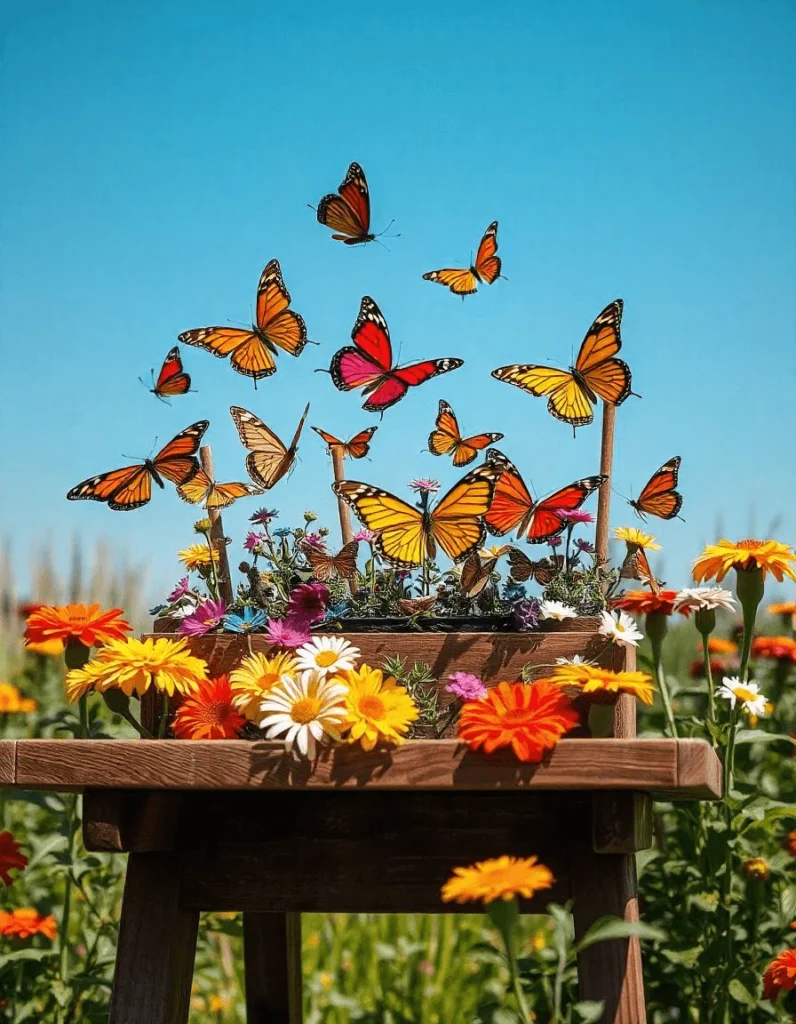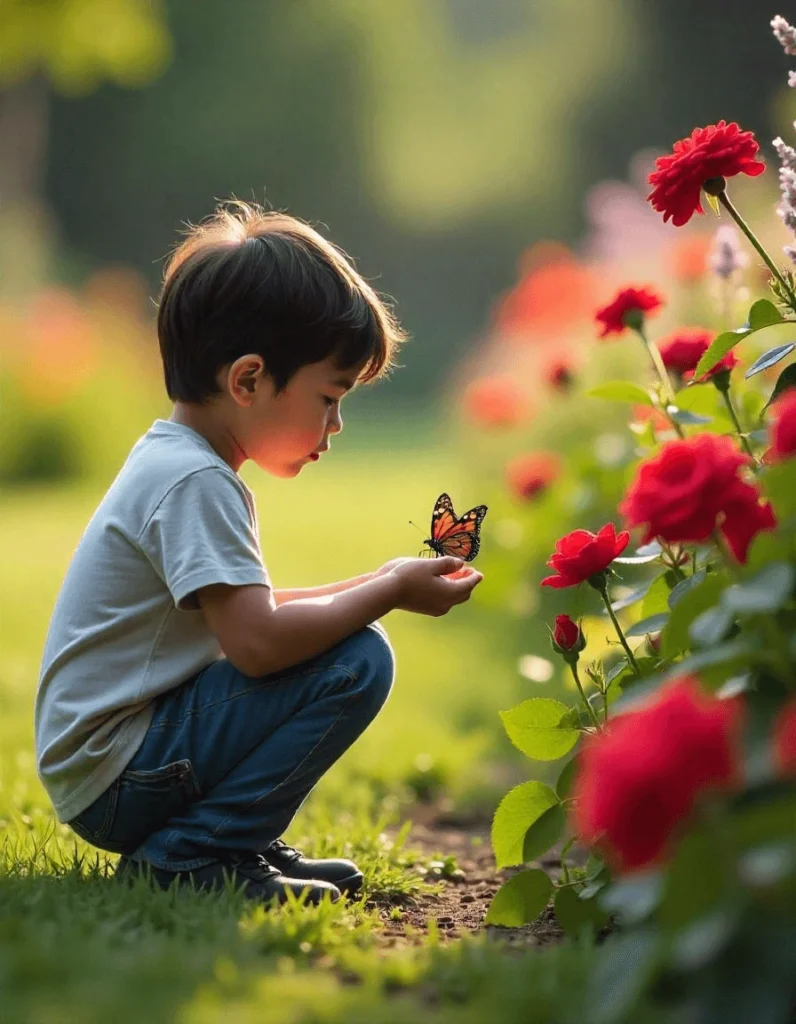Butterfly Garden Kits: Create a Beautiful Haven for Butterflies

1. Introduction
Have you ever dreamed of transforming your backyard into a butterfly paradise? Butterfly garden kits are the perfect way to invite these delicate pollinators into your outdoor space while also supporting the environment. Whether you’re a seasoned gardener or a beginner, these kits provide everything you need to create a vibrant and thriving butterfly-friendly garden.
Butterflies are not just beautiful creatures fluttering around—they play a crucial role in pollination, helping flowers, fruits, and vegetables flourish. By setting up a butterfly garden, you contribute to preserving butterfly populations, which have been declining due to habitat loss and environmental changes.
In this guide, we’ll explore everything you need to know about butterfly garden kits—from choosing the right one to maintaining it year-round. Ready to dive in? Let’s get started!
2. Components of a Butterfly Garden Kit
When you purchase a butterfly garden kits, you’ll find several essential elements inside. These kits are designed to provide a complete ecosystem that attracts, nourishes, and shelters butterflies.
Essential Elements Included in a Kit
Most butterfly garden kits contain:
- Butterfly-friendly seeds – These include a mix of nectar-rich flowers and host plants.
- Soil and fertilizer – Ensures the plants grow well.
- Planting instructions – Step-by-step guidance on how to set up your garden.
- Butterfly habitat accessories – Some kits come with butterfly houses or feeders.
Types of Butterfly-Friendly Plants
A good butterfly garden kits will include a variety of flowers and plants that serve different purposes:
- Nectar plants – These provide food for adult butterflies. Examples: Coneflowers, Milkweed, and Zinnias.
- Host plants – These support caterpillar growth. Examples: Parsley, Dill, and Fennel.
Additional Tools and Accessories
Some premium kits include:
- Decorative stones for butterflies to rest on.
- Small water trays for hydration.
- Informational booklets to help you identify butterfly species.
3. Choosing the Right Butterfly Garden Kit

Not all butterfly garden kits are created equal! Here’s what you need to consider when selecting the perfect kit for your needs.
Factors to Consider Before Purchasing
- Plant Variety – Ensure the kit contains both nectar and host plants.
- Region-Specific Plants – Choose plants that thrive in your climate.
- Ease of Use – Some kits are beginner-friendly, while others require more effort.
Best Butterfly Garden Kits Available
There are several popular options on the market, including:
- Pollinator Paradise Kit – Contains a variety of flowers and host plants.
- Children’s Butterfly Garden Kits – A fun and educational option for kids.
- Wildflower Butterfly Kit – Focuses on native wildflowers that attract butterflies.
DIY vs. Pre-Made Kits
Consider making your butterfly garden kit if you prefer a personalized touch. This allows you to handpick your favorite plants and design the layout exactly how you want. However, pre-made kits provide a ready-to-go solution if you’re looking for convenience.
4. Setting Up Your Butterfly Garden
Once you’ve selected the perfect butterfly garden kit, it’s time to bring your vision to life. Here’s a step-by-step guide to help you get started.
Step-by-Step Guide to Planting
- Choose a sunny spot – Butterflies love warmth, so select an area that receives at least six hours of sunlight.
- Prepare the soil – Loosen the ground and mix in nutrient-rich compost.
- Plant the seeds or seedlings – Follow the spacing instructions provided in the kit.
- Water gently – Keep the soil moist but avoid overwatering.
Placement Considerations for Maximum Success
- Plant nectar flowers in clusters to make it easier for butterflies to find food.
- Keep host plants nearby so butterflies can lay their eggs.
- Add rocks or flat surfaces where butterflies can sunbathe.
Maintaining a Healthy Butterfly Habitat
- Water your plants regularly, but avoid spraying the butterflies directly.
- Remove weeds that compete with butterfly-friendly plants.
- Avoid pesticides, as they can be harmful to butterflies.
5. Best Plants for a Butterfly Garden
The right plants are the heart of a successful butterfly garden.
Nectar-Rich Flowers to Attract Butterflies
- Milkweed – Essential for monarch butterflies.
- Zinnias – Bright and long-blooming.
- Coneflowers – A favorite among many butterfly species.
Host Plants for Caterpillars
- Dill – Supports black swallowtail caterpillars.
- Fennel – Provides nourishment for young caterpillars.
- Passionflower – Attracts Gulf fritillary butterflies.
Seasonal Plant Selections
- Spring – Lilacs, violets, and wild indigo.
- Summer – Black-eyed Susans, lavender, and bee balm.
- Fall – Goldenrod, aster, and sedum.
6. Providing Water and Shelter for Butterflies

While plants are essential, butterflies also need water and shelter to thrive. Ensuring they have a safe, inviting environment will keep them coming back to your garden.
Importance of Water Sources
Butterflies don’t drink from open water sources like birds do. Instead, they engage in “puddling,” where they absorb moisture and minerals from damp soil or shallow water. Here’s how to create one:
- Fill a shallow dish with damp sand and place it in a sunny spot.
- Add a few flat stones for butterflies to rest on.
- Occasionally sprinkle water to keep it moist.
Creating Resting Spots and Hiding Areas
Butterflies need shelter from harsh weather and predators. Provide resting places by:
- Placing flat rocks where butterflies can sunbathe.
- Growing dense shrubs or tall grasses as windbreaks.
- Adding butterfly houses for extra protection.
DIY Butterfly Puddling Stations
A simple way to offer water and nutrients:
- Use a terracotta saucer filled with soil and sand.
- Add a pinch of salt or fruit slices for extra minerals.
- Keep it moist to attract butterflies throughout the day.
7. Encouraging Butterfly Reproduction

If you want butterflies to stay and reproduce, you’ll need to create an environment that supports their entire life cycle.
How to Support the Butterfly Life Cycle
Butterflies go through four stages: egg, caterpillar (larva), chrysalis (pupa), and adult. To support them:
- Grow host plants where butterflies lay their eggs.
- Provide plenty of nectar sources for adult butterflies.
- Keep an eye out for caterpillars and avoid disturbing them.
Best Host Plants for Caterpillars
Different butterflies prefer specific host plants. Some of the best include:
- Milkweed – Essential for Monarchs.
- Dill & Parsley – Loved by Black Swallowtails.
- Passionflower – Perfect for Gulf Fritillaries.
Protecting Eggs and Larvae
- Avoid using pesticides.
- Place host plants in protected areas to keep them safe from strong winds.
- Monitor for natural predators like birds or wasps.
8. Common Butterfly Species in Gardens
Attracting butterflies to your garden is exciting, but identifying them is just as rewarding! Here are some of the most common species found in butterfly gardens.
Popular Butterfly Species in North America
- Monarch Butterfly – Famous for its migration patterns and love for milkweed.
- Black Swallowtail – Recognizable by its dark wings and blue markings.
- Painted Lady – A widespread species that thrives on many nectar flowers.
- Gulf Fritillary – Distinctive orange and black spotted wings.
Identifying Different Butterflies
- Look at wing patterns and colors.
- Observe flight patterns—some glide smoothly, while others flutter quickly.
- Take note of preferred plants.
Best Plants for Attracting Specific Species
- Monarchs – Milkweed, Butterfly Bush.
- Swallowtails – Dill, Fennel, Parsley.
- Painted Ladies – Thistle, Aster, Sunflowers.
9. Maintaining Your Butterfly Garden Year-Round
A thriving butterfly garden needs ongoing care. Here’s how to maintain it through every season.
Seasonal Care Tips
- Spring – Prepare the soil, plant new nectar flowers, and check for overwintering chrysalises.
- Summer – Keep plants well-watered and remove invasive weeds.
- Fall – Plant late-blooming flowers to support migrating butterflies.
- Winter – Leave dried plants and fallen leaves for caterpillars and pupae.
Pruning and Plant Maintenance
- Trim overgrown plants, but avoid cutting host plants that may house caterpillars.
- Remove dead flowers (deadheading) to encourage new growth.
- Compost old plant material instead of burning it to protect overwintering butterflies.
Encouraging Butterfly Visits Throughout the Year
- Plant a variety of flowers that bloom at different times.
- Provide shelter in the form of butterfly houses or tall grass patches.
- Continue to replenish puddling stations with water and minerals.
Top On Sale Product Recommendations!
6x8FT Wooden Greenhouse, Greenhouse for Outdoors with Cedar Frame, 4-layer Polycarbonate Panel, Green House with Adjustable Vent
Price Now: USD 704.94 (Original price: USD 1566.54, 55% off)
Buy Now
10. The Role of Butterfly Gardens in Conservation
Butterfly populations are declining, but your garden can help!
Helping Declining Butterfly Populations
- Habitat loss is a major threat, and butterfly gardens provide safe environments.
- Pesticide-free gardens help protect butterflies from harmful chemicals.
- Encouraging native plants supports local butterfly species.
Creating Safe Habitats
- Avoid non-native plants that might disrupt ecosystems.
- Offer a mix of nectar and host plants.
- Provide pesticide-free zones where butterflies can safely feed and reproduce.
Educating Others About Butterfly Conservation
- Teach children about the butterfly life cycle.
- Join local conservation programs.
- Share your butterfly garden journey with friends and family.
11. DIY Butterfly Garden Kits: Step-by-Step Guide
If you prefer a hands-on approach, here’s how to assemble your butterfly garden kit.
How to Assemble Your Kit
- Choose a Container – Use a large planter or raised garden bed if space is limited.
- Select Native Plants – Research butterfly-friendly plants that grow well in your area.
- Include Water & Shelter Elements – Add a butterfly puddler and resting stones.
- Arrange Your Garden – Group nectar flowers together for better visibility.
Budget-Friendly Tips
- Collect seeds from existing plants instead of buying new ones.
- Use recycled containers for puddling stations.
- Swap plants with fellow gardeners.
Where to Source Plants and Materials
- Local nurseries often have native plants suited for butterflies.
- Online stores offer butterfly garden seed mixes.
- Gardening clubs and conservation groups may provide free or discounted seeds.
12. Common Mistakes to Avoid in a Butterfly Garden
Avoid these pitfalls to ensure a thriving butterfly habitat.
Harmful Practices That Deter Butterflies
- Using chemical pesticides and herbicides.
- Planting non-native flowers that don’t attract butterflies.
- Failing to provide host plants for caterpillars.
Mistakes in Plant Selection
- Choosing only nectar plants and forgetting host plants.
- Planting invasive species that outcompete butterfly-friendly plants.
Overuse of Pesticides and Chemicals
- Even organic pesticides can harm butterflies—use natural alternatives like companion planting.
13. Fun Activities for Kids with Butterfly Gardens
Get kids involved in gardening while teaching them about butterflies!
Educational Opportunities
- Learn about the butterfly life cycle firsthand.
- Observe and document butterfly behavior.
Hands-On Butterfly Observation
- Keep a butterfly journal.
- Take pictures of different butterfly species.
Creating Butterfly Journals
- Record butterfly visits, plant growth, and weather conditions.
14. Expanding Your Butterfly Garden Over Time
Once your butterfly garden is established, consider expanding it.
Adding More Plants and Flowers
- Introduce more nectar and host plants to attract different butterfly species.
Encouraging Biodiversity
- Attract bees, hummingbirds, and other pollinators by planting diverse flowers.
Introducing Additional Pollinators
- Grow plants that support bees and hummingbirds to create a more dynamic ecosystem.
15. Conclusion
A butterfly garden kit is an easy, rewarding way to attract these beautiful creatures while helping the environment. By planting the right flowers, providing water, and creating a safe space, you can enjoy a garden full of fluttering wings all year round.
Start small, stay patient, and watch your garden transform into a butterfly paradise!
FAQs
- What are the best butterfly garden kits for beginners?
- Look for kits with a mix of nectar and host plants, easy-to-follow instructions, and low-maintenance flowers.
- How long does it take for butterflies to visit a new garden?
- It may take a few weeks, but planting bright flowers and providing water sources speeds up the process.
- Can I grow a butterfly garden in a small space?
- Yes! Use containers or raised beds with compact, butterfly-friendly plants.
- Do butterfly gardens attract other pollinators?
- Yes, they also attract bees, hummingbirds, and beneficial insects.
- How can I make my butterfly garden kid-friendly?
- Add fun observation tools like magnifying glasses, butterfly charts, and DIY craft projects.

One Comment